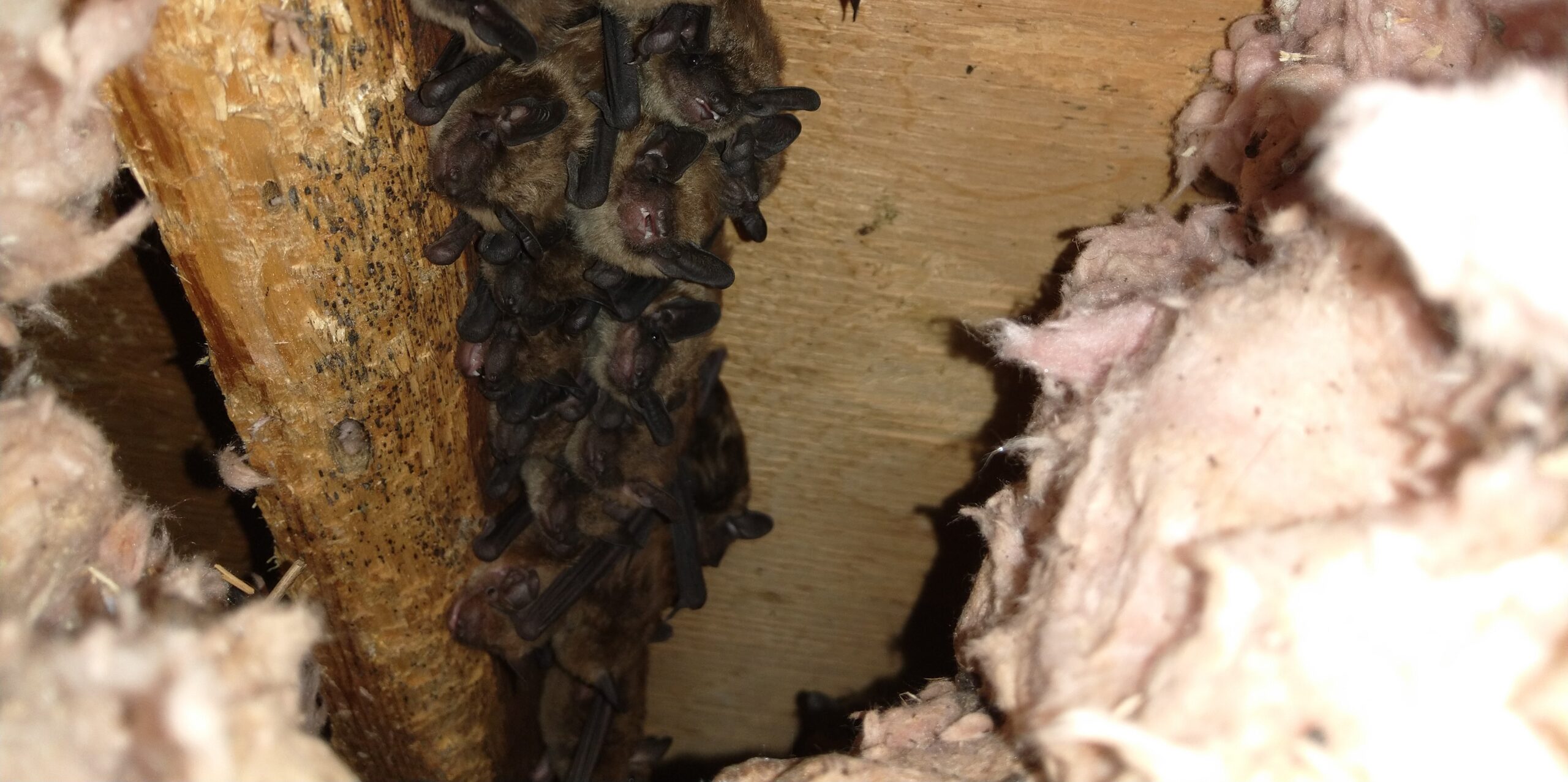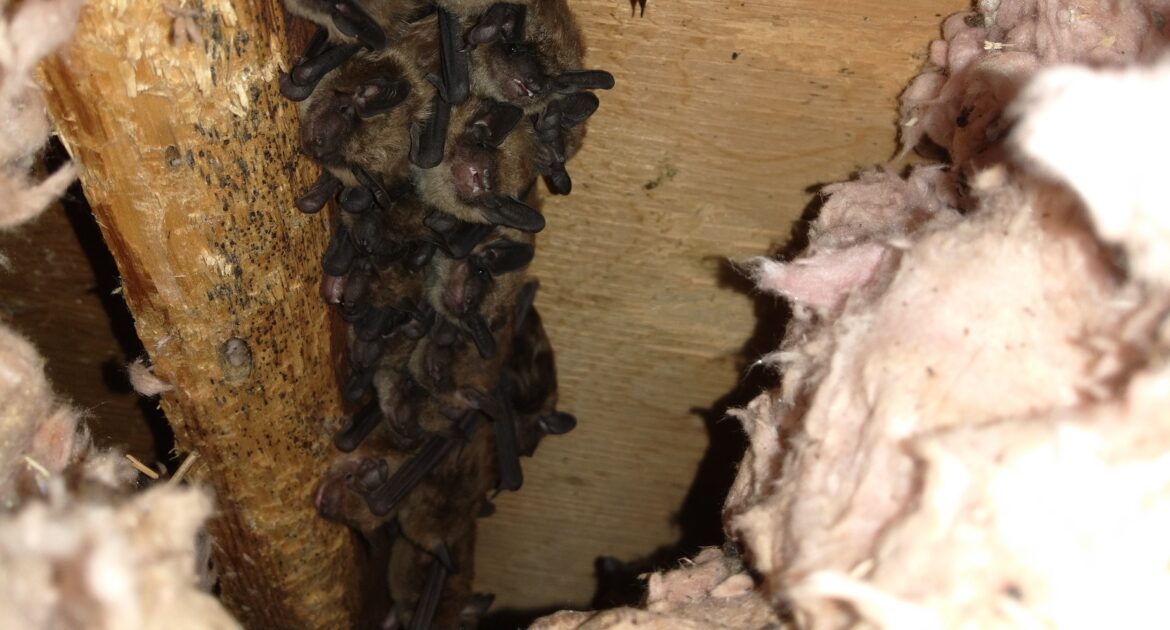You might be surprised to know that bats in Minneapolis winter have some pretty cool tricks up their wings.
When the snow starts falling and temperatures drop, these amazing animals don’t just pack up and fly south like some birds do. Instead, these creatures in winter use special ways to survive the cold months right here in Minnesota.
So, do bats stay in Minneapolis during the winter? Yes, many of them do! But they don’t stay active like they do in summer.
When you’re wondering where bats go in the winter, the answer is that they find warm, safe places to sleep through the coldest months. This process is called hibernation, and bat hibernation in cold climates like Minnesota is one of nature’s most amazing survival tricks.
At Skedaddle Humane Wildlife Control in Minneapolis, we specialize in helping homeowners deal with bats safely and humanely.
In this blog, you’ll learn all about how bats prepare for winter, where they go to hibernate, and why they sometimes choose homes like yours to stay warm.
How Bats Prepare for Winter
You’ve probably noticed that bats are super active during warm summer nights. They fly around eating bugs and living their best lives. But as fall arrives, these smart animals start getting ready for winter in ways that might surprise you.
Bats begin eating much more food in late summer and fall. They’re basically storing up energy for the long winter ahead. Think of it like filling up a gas tank before a really long road trip. The extra fat they build up will keep them alive during the months when there are no bugs to eat.
During this prep time, these animals also start looking for the perfect winter homes. They need places that are:
- Warm enough to keep them from freezing
- Safe from animals that might want to eat them
- Quiet and dark for good sleeping
- Humid enough so they don’t dry out
Where Bats Go in Winter
When you’re curious about where bats go in winter, you’ll find they’re pretty smart about picking their spots. These animals don’t just pick any old place to spend the winter. They look for very specific types of homes that will keep them safe and comfortable.
Natural Winter Homes
Many of them choose natural places like:
- Caves with steady temperatures
- Hollow trees with thick bark
- Rock cracks and cliff faces
- Underground spaces like old mine shafts
Man-Made Winter Homes
But here’s where it gets interesting for Minneapolis homeowners. Bats also love man-made structures because they often have the perfect conditions. They might choose:
- Attics that stay warm
- Wall spaces between rooms
- Basements with steady temperatures
- Garages and sheds
- Barns and other farm buildings
Bat Hibernation in Cold Climates
Bat hibernation in cold climates is pretty amazing when you think about it. Unlike bears who wake up sometimes during winter, these animals go into a much deeper sleep called torpor. Their bodies basically slow way down to save energy.
During hibernation, a bat’s heart rate drops from about 400 beats per minute to just 25 beats per minute. Their breathing slows down too, and their body temperature drops to match their surroundings. This is how they can survive months without eating any food.
What Happens During Hibernation
When these animals are hibernating, they:
- Don’t eat or drink anything
- Barely move at all
- Use up the fat they stored in fall
- Can lose up to half their body weight
- Wake up very slowly when spring comes
Why They Can’t Be Disturbed
You should never try to wake up a hibernating bat. If they wake up too early or too often, they use up their stored energy too fast. This can actually kill them because they won’t have enough energy left to make it through winter.
Different Types of Bats in Minneapolis
Minneapolis is home to several types of bats, and they don’t all handle winter the same way. Some stay here all winter, while others travel to warmer places.
Little Brown
These are the most common type you’ll see in Minneapolis. Little brown bats usually stay in Minnesota all winter long. They find cozy spots in buildings, caves, or trees and hibernate until spring. You might find them choosing your attic or walls for their winter home.
Big Brown
Big brown bats are also pretty common around Minneapolis. Like little brown bats, they usually stick around all winter. They’re especially good at finding warm spots in buildings to hibernate.
Other Species
Some other types do things differently:
- Silver-haired types often fly south for winter
- Red types might migrate or find shelter under tree bark
- Hoary types usually travel to warmer states
Signs Bats Are in Your Home
If bats have chosen your home for their winter hibernation spot, you might notice some signs. It’s important to know what to look for so you can call professionals for help.
What You Might See
- Small, dark droppings that look like rice
- Stains on walls or ceilings
- Strange smells, especially if there are lots of bats
- Scratching or squeaking sounds in walls or attic
- Bats flying around inside your house
What You Might Hear
These animals make different sounds that you can sometimes hear:
- High-pitched squeaking
- Scratching noises in walls
- Fluttering sounds when they move around
- Chattering when they’re active
When You’re Most Likely to Notice Them
You’re most likely to see signs of bats during:
- Early fall when they’re looking for winter homes
- Warm winter days when they might wake up briefly
- Early spring when they start becoming active again
Why Bats Choose Houses
You might wonder why bats would want to live in your house instead of a nice cave somewhere. The truth is, houses can be perfect for bats because they offer everything they need for a good winter’s sleep.
- Temperature Control: Your house stays much warmer than the outside air, but it’s not too warm like the inside of your heated living spaces. Attics and wall spaces often stay at just the right temperature for hibernating bats.
- Safety from Predators: Houses protect bats from animals that might want to eat them, like owls, hawks, or other predators. Inside your walls or attic, bats can sleep peacefully without worrying about becoming someone’s dinner.
- Steady Conditions: Houses don’t have the same temperature swings that outdoor spaces do. This steady environment helps bats maintain their hibernation without waking up too often.
Problems with Bats in Homes
While bats are helpful animals that eat lots of bugs, you don’t want them living in your house. There are several reasons why having these animals in your home isn’t a good idea.
Health Concerns
Bats can carry diseases that are dangerous to people and pets. Their droppings can also create health problems, especially if there are lots of them. This is why it’s so important to have our professionals handle any bat problems.
Property Damage
Over time, bat droppings and urine can:
- Stain ceilings and walls
- Create bad smells that are hard to get rid of
- Damage to insulation and building materials
- Attract insects and other pests
Noise Issues
A few bats might not make much noise, but larger groups can be pretty loud. You might hear them moving around, especially during times when they’re more active.
Spring Wake-Up Time
When spring arrives in Minneapolis, hibernating bats start waking up. This usually happens when temperatures stay above freezing for several days in a row and insects start flying around again.
Bats wake up slowly from hibernation. They need time to get their bodies working normally again. During this time, they might fly around during the day, which is unusual for these animals. They’re just confused and trying to figure out what’s going on.
As they fully wake up, bats start looking for food again. They also start thinking about finding places to have babies in late spring and early summer.
Get Professional Help for Your Minneapolis Bat Problem
If you’ve discovered that bats have chosen your Minneapolis home as their winter retreat, you need professional help right away. At Skedaddle Humane Wildlife Control in Minneapolis, we understand how to handle bats in Minneapolis winter situations safely and effectively.
Our team uses special one-way doors that let bats leave your home but prevent them from coming back in. This humane approach means these animals can find new homes without being hurt, and your family can live in peace without unwanted guests.
Don’t try to handle bat problems yourself. Our professional wildlife control experts know how to work with these animals safely and legally. We also understand where bats go in the winter and can help prevent them from choosing your home again next year.
Understanding bat hibernation in cold climates helps us create solutions that work for both homeowners and these important animals. Contact us today to request an estimate and learn more about how we can help solve your bat problem the right way.




